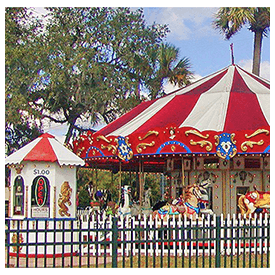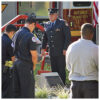
According to Peggy Soules, the widow of Jim Soules who died unexpectedly on Friday, her plans are to “bring the carousel home” to where she lives in Port Charlotte. She is reported to have told televised news sources that the Davenport Park Carousel in St Augustine will take its final turn this Sunday before being dismantled and removed.
When Historic City News interviewed Jim several years ago, he told us the story of how the carousel came to be in his possession in St Augustine. It is not a happy story for the family, which may be contributing to their intention to close the ride and not renew their pending 5-year lease with the City.
Ringling Brothers circus performer Gerard Soules (Jim’s brother) rescued the 1927 C. W. Parker wood-frame carousel from a barn in Mystique, Michigan for $25,000.
At the time of his death, Gerald Soules was living in North Las Vegas and working at the Circus, Circus Hotel and Casino performing a dog act under the big top. One night, in June of 1992, a man broke in to Jerry’s home, burglarized the trailer, then murdered him.
Jim Soules was employed as a deputy sheriff and K-9 trainer in south Florida when he got word of what had happened to Jerry. The sheriff gave him time off to travel to Nevada and assist local authorities in their investigation. Jerry’s killer was found, convicted and now serving his prison sentence.
After Gerard ’s death, the carousel was inherited by his brother, Jim. When Jim Soules returned to Florida, the carousel, reminiscent of old-time circuses and county fairs, was in service at a zoo in Fort Wayne, Indiana. With the assistance of Carl Theel, and Theel Manufacturing, Soules was able to restore the ride.
After some minor controversies and objections, Jim brought the portable carousel to St. Augustine. Soules reached an agreement with the City in 1994 to locate the carousel at the corner of San Carlos Avenue in Davenport Park where it has remained ever since.
The carousel sports two fixed chariots and two rows of a mixture of fiberglass horses and a camel, who parade up and down to the music. All animals are fantastically painted, very colorful, and easy to ride.
Soules says operating the ride is something he does for his brother’s memory. “I operate the ride for Jerry,” Soules told Historic City News editor, Michael Gold. “There’s no way you could pay salaries, rent, and operating expenses for $1.00 a ride and think you were going to make a profit.”
When asked, Soules said that his children all have jobs and he doesn’t think they would want to run the carousel when he gets ready to retire — again. Soules, assisted by Wilson Machine Shop in St. Augustine and one other employee, does all the engineering and repairs on the ride required to keep it safe and fun for his loyal patrons. “I don’t think I’ll sell it,” Soules told Historic City News in 2011. “I’ve probably got another twenty years in me.”
Soules has a shop at his St. Augustine home; which is where the recent repairs and refitting was completed. “It takes about three hours to break the ride down, then about four or five hours to set it back up,” said Soules. “It’s been about ten years since the last time we had to take it all apart.”
“The carousel is like a big umbrella,” Soules explained. “All the horses and platform hang from the canopy above. Ribs from the center stabilize the ride to keep it from swaying.”
The J&S Carousel can carry 20 riders on horseback — four more riders in the chariots. The weight of the carousel is balanced between the horses and the circulating core — the total weight is 10,200 pounds, Soules said.
As a reporter, I got an education about the St. Augustine landmark — and a lot about the history of rides of its type. Did you know, for example, that there is a difference between a “carousel” and a “merry-go-round” and a “roundup”? A roundup travels clockwise, while the merry-go-round and carousel travel counterclockwise.
So, what’s the difference between a merry-go-round and carousel? The St. Augustine ride is a carousel — it is made up of a lead horse, stationary horses, “jumpers”, as well as two “chariots”. A merry-go-round can have other animals such as camels, zebra, and elephants — as well as horses.
Soules explained that the term “carousel” is a modernization of the term “carry us all” — which dates to the time of Ponce de Leon’s discovery of Florida and founding of Menendez’ settlement at St. Augustine.
In the 16th century through the early 1600s in Europe, the king would allow one horse to lead the turnstile; operated during the day by an ox. Attached to the pickets of the turnstile, which was designed to mill grain, were hung swings; which allowed the children an entertaining evening ride.
Discover more from HISTORIC CITY NEWS
Subscribe to get the latest posts sent to your email.




